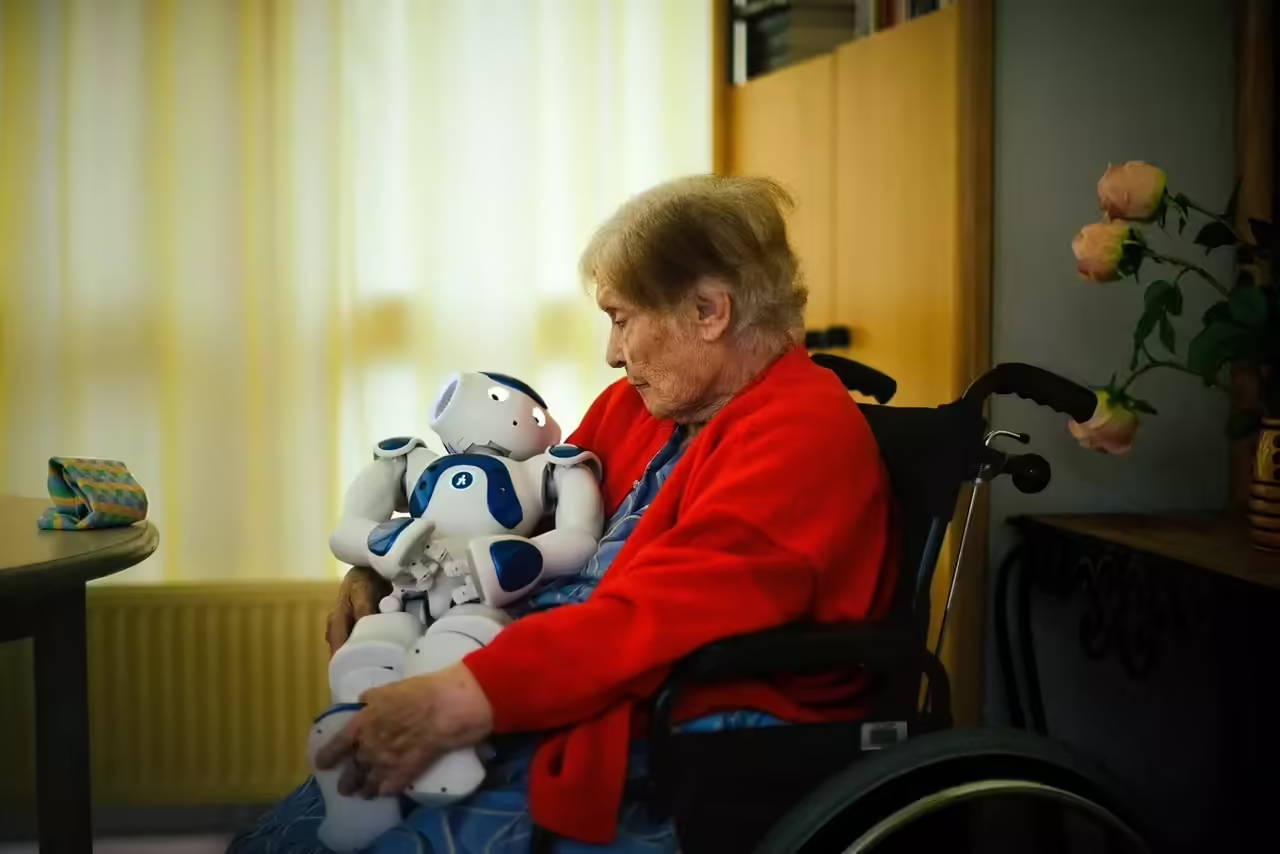
In recent years, the world population has experienced rapid ageing, and many countries face significant challenges in caring for their elderly populations. China, as a nation with a large number of elderly people, has excelled in finding innovative solutions to address this growing demand. One of the emerging technologies that has attracted attention is the use of robots with artificial intelligence (AI) for the care and attention of the elderly.
The combination of robotics and artificial intelligence offers promising potential to improve the quality of life for the elderly and ease the burden on human caregivers. AI robots can perform a variety of tasks, from helping with basic daily activities to providing companionship and entertainment. In China, this technology has become a national priority, and various research projects and programs are underway to develop elderly care robots.
One of the most interesting aspects of the Chinese elderly care revolution is the integration of traditional Chinese culture into the design of the robots. Chinese engineers and designers are working on creating robots that resemble Chinese historical and mythological figures, helping to establish an emotional and cultural connection with the elderly. These robots not only provide hands-on assistance, but can also tell stories, sing songs, and participate in traditional Chinese activities, helping to keep traditions and cultural heritage alive.
In addition to providing companionship and entertainment, AI robots also have the ability to monitor the health of the elderly and provide early warnings in case of any abnormalities. Some models are equipped with biometric sensors that can measure vital signs, detect falls or identify changes in behavior, allowing for quick and efficient intervention in emergency situations. This not only ensures the safety of the elderly, but also provides peace of mind for their families and caregivers.
Despite significant advances, there are still challenges on the road to broader adoption of AI robots in elderly care. The cost of robots remains high, making them difficult to afford for many homes and care facilities. In addition, there is growing concern about the impact of robots on human interaction and the quality of social relationships. Although robots can provide hands-on support, they cannot fully replace the human contact and empathy that human caregivers can provide.
The growing need for elderly care in China and the associated challenges
The growing need for elderly care in China is a challenge that the country has been actively addressing. The aging of the Chinese population has accelerated rapidly due to several factors, such as the declining birth rate and the increase in life expectancy. According to Chinese government data, it is estimated that by the year 2050, approximately 39% of the Chinese population will be over 60 years of age.
This demographic trend poses a number of significant challenges for the elderly care system in China. One of the key challenges is the shortage of trained human caregivers. With large numbers of older people needing care and a limited number of carers available, an innovative and sustainable solution is required.
In addition, caring for the elderly involves a wide range of needs, ranging from support in basic daily activities to specialized medical care. The cost and availability of long-term care services are also areas of concern. Many Chinese families face difficulties in accessing quality and affordable services for their elderly loved ones.
The infrastructure and design of the environments also pose challenges. Many Chinese cities are designed for a younger population and may not be adequately equipped to meet the needs of the elderly. For example, physical accessibility in terms of barrier-free facilities and adapted transportation may be insufficient.
In response to these challenges, China has been investing in the development and implementation of innovative technologies, such as AI robots, to provide care for the elderly. These robots can help with daily tasks, monitor health, provide companionship and entertainment, and ease the burden on human caregivers.
However, there are also challenges associated with the widespread adoption of robots in elderly care in China. One of them is the high cost of robots, which limits their accessibility for many families and care centers. Additionally, acceptance and trust in robots by the elderly and their families may also be obstacles to overcome.
Another major challenge is finding the right balance between robotic care and human interaction. While robots can provide hands-on assistance, they cannot fully replace the human contact and empathy that human caregivers provide. It is essential to ensure that the implementation of robotic technologies in the care of the elderly is carried out in an ethical and careful manner, prioritizing the well-being and quality of life of the elderly.
The advent of AI robots: a promising solution for elderly care in China?
The arrival of robots with AI is presented as a promising solution for the care of the elderly in China. These AI-powered robots can play an important role in the care and well-being of the elderly, offering a variety of benefits and addressing some of the challenges mentioned above.
First, AI robots can provide practical assistance in the basic daily activities of the elderly. They may help with tasks such as lifting and transferring people, preparing food, cleaning the home, and administering medications. These capabilities can ease the burden on human caregivers and allow the elderly to maintain their independence and autonomy for longer.
AI-powered robots can play a vital role in monitoring the health of the elderly. These robots are equipped with biometric sensors that can measure vital signs such as blood pressure, heart rate, and body temperature. They can also detect falls and send alerts to emergency services or human caregivers. This continuous monitoring capability can help prevent and rapidly respond to critical medical situations.
Another important aspect is the companionship and entertainment that AI robots can provide to older people. These robots can interact in a friendly way, tell stories, sing songs and participate in recreational activities. This social interaction can reduce loneliness and isolation, common problems among older people, and contribute to their emotional and mental well-being.
In the specific context of China, the integration of traditional Chinese culture into the design of AI robots is an added advantage. By creating robots that resemble Chinese historical and mythological figures, a stronger emotional and cultural connection with the elderly can be established. This can help preserve traditions and cultural heritage, and provide a sense of familiarity and belonging to the elderly.
However, it is important to note that AI robots cannot completely replace human care. Human interaction, emotional support and empathy continue to be essential in caring for the elderly. Robots should complement and enhance human care, rather than replace it.
There are challenges to consider in the widespread adoption of AI robots in elderly care in China. Cost and accessibility remain significant barriers, and solutions need to be found to make this technology more affordable and widely available. It is also important to address privacy and ethical concerns in relation to the use of AI in elderly care.
Ethical and social considerations in the use of AI robots for elderly care in China
The use of AI robots for elderly care in China raises a number of important ethical and social considerations that need to be taken into account. As this technology develops and is implemented, it is essential to address these aspects to ensure the well-being and dignity of the elderly. Here are some key considerations:
Privacy and security: AI robots collect and process personal and medical data of the elderly. It is essential to guarantee the protection of privacy and the security of this data, avoiding the misuse or unauthorized disclosure of sensitive information. Robust security measures and clear protocols must be established to protect the privacy of the elderly and obtain their informed consent.
Human relationships: While AI robots can provide practical assistance and companionship, they cannot replace meaningful human relationships. It is important that the use of robots does not lead to social isolation or impairment of human interactions. The elderly must have continuous access to care and support from human caregivers, and robots must complement, rather than replace, human interaction.
Dignity and autonomy: AI robots must be designed and used in ways that respect the dignity and autonomy of older people. This involves considering individual preferences, enabling informed decision-making, and respecting autonomy to the extent possible. The elderly must have the ability to control and customize the interactions with the robots according to their needs and desires.
Equity and accessibility: Access to AI robot technology for elderly care should not be limited by economic or social considerations. It is essential to ensure equity and accessibility, especially for those elderly who face economic challenges or have physical or cognitive limitations. The cost of robots and associated services must be affordable, and policies promoting equal access must be implemented.
Transparency and accountability: It is important to establish clear and transparent regulation in the development and use of AI robots in elderly care. Ethical standards and liability rules must be established to ensure that robots are used ethically and that service providers are held accountable for their use.
Labor impact: The widespread deployment of AI robots in elderly care may have an impact on workers in the sector, such as human caregivers. It is important to consider the effects on employment and work on restructuring roles and training workers to adapt to this new reality.
Current and future developments in the implementation of AI robots in elderly care in China
China has been experiencing significant developments in the implementation of AI-enabled robots in elderly care, and these are expected to continue to develop in the future. Below are some current developments and possible future trends in this field:
Research and development – China has invested heavily in the research and development of AI-enabled robots for elderly care. Numerous projects are being carried out in collaboration with universities, companies and research centers to improve the functionality and efficiency of robots. These efforts are expected to drive the development of more advanced and versatile robots in the future.
Integration of advanced technologies: In addition to artificial intelligence, elderly care robots in China are expected to integrate other advanced technologies, such as computer vision, voice recognition, and natural interaction. These capabilities will enable greater interaction and communication between robots and the elderly, thus improving their experience and satisfaction.
Personalization and adaptability: Future developments will focus on the personalization and adaptability of robots to the individual needs of the elderly. It is expected that robots will be able to learn and adapt to the preferences and routines of each elderly person, providing more personalized care and improving quality of life.
Advances in health monitoring: AI robots in China are being equipped with more sophisticated and accurate sensors for health monitoring. These advances are expected to enable earlier detection of health problems, such as cardiovascular disease, diabetes and cognitive decline. In addition, robots will be able to provide medication reminders and tracking, as well as healthy lifestyle advice.
Expanding connectivity: The connectivity of AI-enabled robots is expected to expand in the future, enabling better coordination between robots, human caregivers and healthcare systems. This will facilitate communication and the exchange of relevant information, ensuring more comprehensive and coordinated care for the elderly.
Social and emotional robots: AI robots in China are expected to become more sophisticated in terms of social and emotional interaction. In addition to providing hands-on assistance, these robots will be able to recognize and respond to the emotions of the elderly, providing emotional support and meaningful companionship. This will help address loneliness and social isolation in the elderly.







